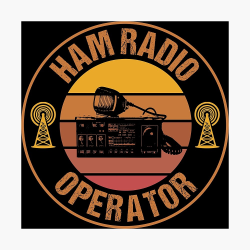Ham Radio

After writing about the pioneer in radio, Lee De Forest, last week, I spent some time reading more about the evolution of radio.
Then on listening to the news that day, there was word of a massive volcanic eruption in the Pacific island group, the Kingdom of Tonga, and a possible incoming tsunami to the United States west coast.
Over the next few days, I listened out for news of the fate of the people of Tonga, but what was repeatedly said, was that there had been no way for anyone to contact Tonga, because a lone cable under the sea had been severed when the volcano erupted.
It got me to wondering "well how did people contact Tonga before there were submarine cables...?" As I suspected, it was radio! As well as official channels, there used to be lots of ham radio operators across the globe, who helped with ground reporting on conditions and needs in emergencies.
Ham radio, often called amateur radio, derived its name from a derisive term for clumsy telegram operators in the 19th century referred to as “ham-fisted.” The name reflects that the technicians are, well, amateurs.
The operators broadcast at several wavelengths using off-the-shelf equipment. It’s a hobbyist space a few notches above citizen’s band radio in both scope and distance signals can travel, and amateur radio operators often talk to each other at the same frequency.
Again, I found myself thinking about how life was so much simpler back in the times of our childhood. We are so reliant on new-fangled technology these days, that the old ways seem to have been discarded, but the incident in Tonga is a vivid demonstration of the fragility of modern internet.
Currently, there's an estimated 436 undersea internet cables, carrying 99% of international internet traffic. In the US, we have multiple lines, but poorer nations like Tonga have to rely on just one. That's a cable, about the thickness of a garden hose and filled with fragile fiber-optic filaments...
So, I think we need more ham radio enthusiasts, and I've decided I'm going to try get my license. For a start, I'm definitely ham fisted haha!
Old time radio broadcaster, Jean Shepherd (The Jean Shepherd Show), was very active on ham radio right up until his death. He held the ham radio call signs W9QWN (2907 Cleveland St., Hammond, Ind.) and later K2ORS (New York). He's also credited as the voice for the ARRL's tape series Tune In the World with Ham Radio, which helped many young people become ham radio operators. I'm trying to find a copy of the series, so I can at least start with a familiar voice.
I also know we have several members who have built their own radio sets, so if anyone has any tips or knowledge to share on how to get started, I'd love to hear about it in the comments below. Right now, phrases such as 'good skywave propagation', and the 'condition of the ionosphere' are making my old brain hurt!
Happy listening my friends,
